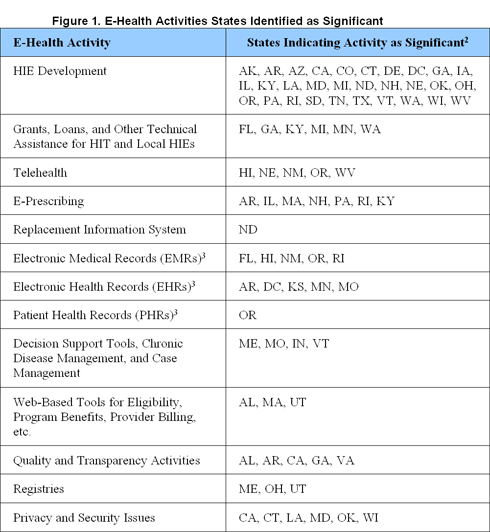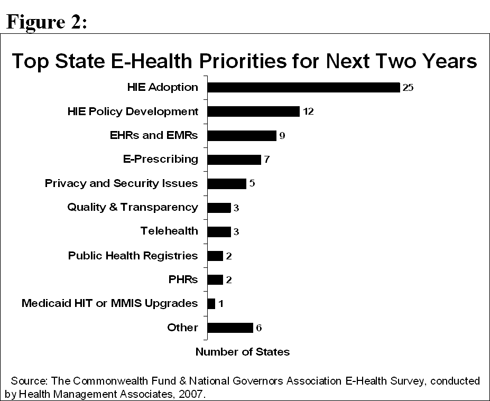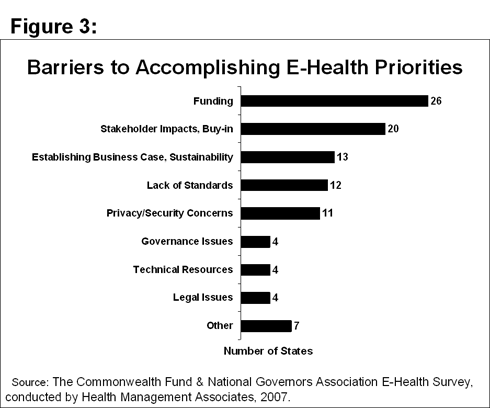| Please take a moment to answer this six-question survey to help us improve the States in Action newsletter. We appreciate and welcome your feedback. |
Today, most states are actively promoting the use of information technology as a way to improve the efficiency and effectiveness of health care. "E-health" describes any health care practice supported by electronic processes and communication; state e-health initiatives include health information exchanges and use of technology such as telehealth, e-prescribing, electronic medical records, and decision support tools. States are encouraging e-health activities in the private sector and in a wide variety of public programs, from public health agencies, Medicaid, and state employee health benefits plans to state-run mental health hospitals and prison systems. Consensus among states has emerged that, despite significant implementation challenges, e-health policies and initiatives are well worth the effort.
The Commonwealth Fund partnered with the National Governors Association (NGA) and Health Management Associates (HMA) to survey states about their current e-health activities, the challenges they have faced, and opportunities for further development. Forty-one state governors' offices and the mayor's office in the District of Columbia responded, providing a rich set of data and an important baseline of state progress. This article summarizes key findings from the survey report. [1]
E-Health Priorities
All states place a high priority on e-health. Nearly 70 percent of respondents said that e-health activities are very significant. When asked about activities they are developing or implementing, respondents named as particularly important the creation of health information exchanges (HIEs), in which stakeholders come together to electronically transfer health care information across organizations in order to improve the quality, safety, and efficiency of care (Figure 1). States also cited the adoption of health information technology (HIT) related to information generation, storage, and transmission.

Electronic health information exchanges top governors' e-health priorities.
When asked to identify their governor's two highest e-health priorities for the next two years, more than three-quarters of the states identified HIE activities (Figure 2). Eleven states have formed a statewide committee, commission, or board to study HIE issues; 17 are involved in other HIE planning and monitoring activities; and seven have developed or implemented HIEs (Arizona, Colorado, Delaware, District of Columbia, Kentucky, Louisiana, and Oklahoma). Four states (Florida, Georgia, Minnesota, and Washington) provide grants to spur both HIT and HIE development.

|
Public health agencies have extensive experience operating electronic registries, which will be the foundation for other e-health activities. For decades, many state public health agencies have operated electronic registries related to immunization, disease and other surveillance, newborn screening, and Medicaid's Early and Periodic Screening, Diagnostic, and Treatment program. All but one of the states said they operate one or more of these registries. Five states reported that their public health agencies use electronic medical records (Indiana, Massachusetts, New Mexico, Tennessee, and Utah) and three states said these agencies use electronic health records (EHRs) (Kansas, Tennessee, and West Virginia).
|
Nearly all state Medicaid agencies are pursuing e-health initiatives. Over half of the states reported implementing Web-based Medicaid Management Information Systems (MMIS), telehealth, and decision support tools. About a third of states reported use of Web-based provider enrollment and certification and immunization registries.
|
Barriers to Accomplishing State E-Health Priorities
Funding and stakeholder buy-in are the most significant barriers to e-health adoption. More than half of respondents identified lack of funding as the greatest obstacle they faced in pursing their e-health priorities (Figure 3). Thirteen states also referred to the barriers of sustainability or difficulty in establishing a "business case," in which revenues or savings from the use of HIT would offset its additional cost. Almost half of the states mentioned the challenge of obtaining the trust, buy-in, and participation of stakeholders.

Privacy and security remain key concerns of states. Most states participating in the survey said they have privacy laws and other protections in place, and two-thirds reported establishing policies and procedures to address data privacy and security breaches. Six states (California, Connecticut, Louisiana, Maryland, Oklahoma, and Wisconsin) listed actions related to privacy and security among their most significant e-health activities.
Differing consent requirements are the greatest barrier to release of health information, especially for services related to substance abuse, mental health, and HIV/AIDS. Federal and state laws may regulate the terms of consent for all disclosures for payment and treatment purposes for mental health, substance abuse, and HIV/AIDS. Most of the states found the consent process for these types of care to be difficult. In addition, most states indicated that federal laws related to substance abuse services create a barrier to implementing an HIE. Thirteen states reported that state and federal confidentiality and consent laws complicate e-health activities and nine states reported that the Health Insurance Portability and Accountability Act preemption standards are a barrier. Other barriers mentioned include the technological challenges of securing and authenticating data.
Lessons Learned from State E-Health Activities
States emphasize the need for collaboration and stakeholder engagement. States were asked to offer "lessons learned" from the e-health activities they identified as most significant. By far the most commonly cited lesson was the need to collaborate with and obtain the buy-in of the full range of stakeholders.
The Commonwealth Fund e-health report can be used by states to facilitate collaboration. The report, State E-Health Activities in 2007: Findings From a State Survey, provides a benchmark of state activities, showing what they have achieved and where they are headed during fiscal year 2008. States can use this resource to learn from their colleagues and further their own efforts. The National Governors Associate will share lessons from the report through its Center for Best Practices. It will also use the report to help build consensus for interoperability among health information systems across the nation through its State Alliance for e-Health .
"It was very clear from state responses that much of the progress states have made has not been easy," says Vernon K. Smith, a principal at Health Management Associates and an author of the report. "There are big challenges, but state officials believe the payoff will be worth the effort in terms of quality, efficiency and cost-effectiveness in the health system, and that the benefits will accrue to all stakeholders, from patients and providers to employers and insurers."
|
References
[1] V. K. Smith, K. Gifford, S. Kramer et al., State E-Health Activities in 2007: Findings From a State Survey, The Commonwealth Fund, February 2008.
[2] HMA asked states to identify their two most significant e-health activities. Some states described multiple initiatives as one activity, e.g., telehealth with electronic prescribing and HIE adoption. HMA subdivided such responses into the activities shown in Figure 1, when possible.
[3] An electronic medical record (EMR) is a computer-based patient medical record. The EMR is the source of information for the electronic health record (EHR). An EHR is a longitudinal electronic record of patient health information generated in one or more care settings. The term personal health record (PHR) is usually used when referring to an EMR or EHR that is owned by the patient. Source: HIMSS Dictionary of Healthcare Information Technology Terms, Acronyms and Organization, 2006.


